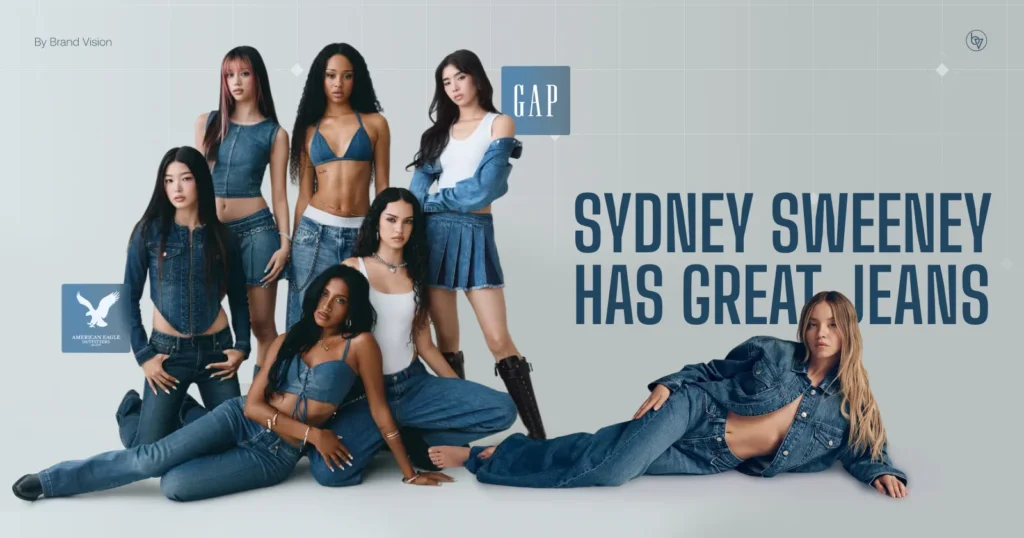
Two major denim ads took over 2025. Gap’s KATSEYE collab went viral for its joy and inclusivity, while American Eagle’s Sydney Sweeney ad sparked controversy. What can we learn from their different outcomes?
In mid 2025, denim took centre stage in two very different campaigns. Gap enlisted global pop group KATSEYE for a bright and high-energy “Better in Denim” spot, reviving the brand’s heritage of dance-driven, inclusive ads. The ad quickly exploded and racked up more than 20 million Instagram views and boosted the company’s quarterly sales by 14%. Meanwhile, American Eagle turned Euphoria star Sydney Sweeney for a stripped back denim campaign leaning on the provocative pun “genes vs. jeans”. While the campaign gained virality, it sparked backlash over tone-deaf messaging and cultural insensitivity. Together, these ads reveal two very different approaches to brand storytelling, and the possible consequences they might face.
Gap × KATSEYE: Nostalgia and Global Appeal
Gap’s KATSEYE collaboration signaled a strategic revival of its brand identity. Known for its iconic late 1990s and early 2000s dance ads, Gap used nostalgia while also refreshing it for a new generation. The commercial featured the six members of the global pop group KATSEYE. The ad showcased the girls dancing in low rise and long and lean jeans to Kelis’s 2003 hit Milkshake which adds to the nostalgic, y2k vibe the ad brings. Bright visuals, choreography, and playful styling made it an instant hit across all social media platforms with fans replicating the moves and boosting its visibility.
The campaign quickly became a cultural phenomenon. Gap reported a 14% increase in comparable sales and over 400 million digital views within weeks. Critics praised its inclusivity, global appeal, and its ability to connect authentically with a global youth audience. Rather than simply selling jeans, Gap leaned into joy, diversity, and music-driven storytelling which managed to transform a marketing push into a cultural moment.
American Eagle × Sydney Sweeney: Provocation and Backlash
In contrast, American Eagle’s campaign featuring Sydney Sweeney took a more provocative route. Shot with minimalistic visuals and a deliberately provocative tagline, the ad featured Sweeney in classic denim looks, with the central hook being the phrase “genes vs. jeans”. While intended as a playful pun, many critics pointed out the underlying themes of “eugenics” that made the slogan feel uncomfortable and tone-deaf. For a brand marketing to socially aware Gen Z consumers, this was a huge misstep.
Despite the negative feedback this ad received, the campaign achieved a massive reach and garnered more than 40 billion impressions and brought in close to 800,000 new customers, with American Eagle’s stock surged over 30%. But in saying this, in-store traffic dipped slightly, suggesting that virality did not necessarily translate into sustained loyalty. Online, memes filled the internet, and fashion writers criticised its reliance on shock value over substance. What was meant to be a bold branding instead became a case study in how easily branding can backfire when chasing virality.
Head-to-Head: Joy vs. Shock
When comparing the two campaigns side by side, Gap and American Eagle’s denim strategies reveal a fundamental split in branding philosophy. Gap was able to embrace authenticity and nostalgia, tapping into Gen Z’s love for the Y2K aesthetic and their love for global pop culture. By choosing to partner with KATSEYE, Gap signaled an understanding of how music and dance drive online virality, which is ultimately how they naturally spread across platforms such as TikTok and Instagram. The campaign’s inclusivity and bright tone made it feel culturally fluent rather than forced which then generated clicks that converted social buzz into tangible retail growth.
American Eagle, by contrast, leaned on provocation and star power. Sydney Sweeney is a cultural icon in her own right, with strong appeal among young audiences. But the reliance on a pun that many found tone-deaf and insensitive undermined its credibility. Yes, they were able to create buzz and garner attention but the conversation was skewed more toward criticism rather than celebration.
The contrast between these two highlights a bigger point: not all virality is equal. Gap’s ad campaign cultivated goodwill and nostalgia that consumers wanted to share, while American Eagle’s controversy produced divisive memes and online discourse. In the attention economy, both outcomes can be seen as successful but only one fosters trust and long-term brand loyalty.
Lessons for 2025 Branding
Both these campaigns highlight the stakes of branding in 2025. Today’s audiences reward brands that feel culturally fluent and authentic, not just visible. Gap was able to do just that by channeling diversity and joy in ways that resonated with Gen Z. American Eagle’s pun-driven campaign gained attention but lost credibility which then became a cautionary tale about chasing virality at the expense of trust.
The Lesson is clear: virality alone is not enough. Campaigns must be culturally sensitive and socially in-tune to build brand loyalty. Without cultural sensitivity and social awareness, brands might face not only backlash but long-term damage.